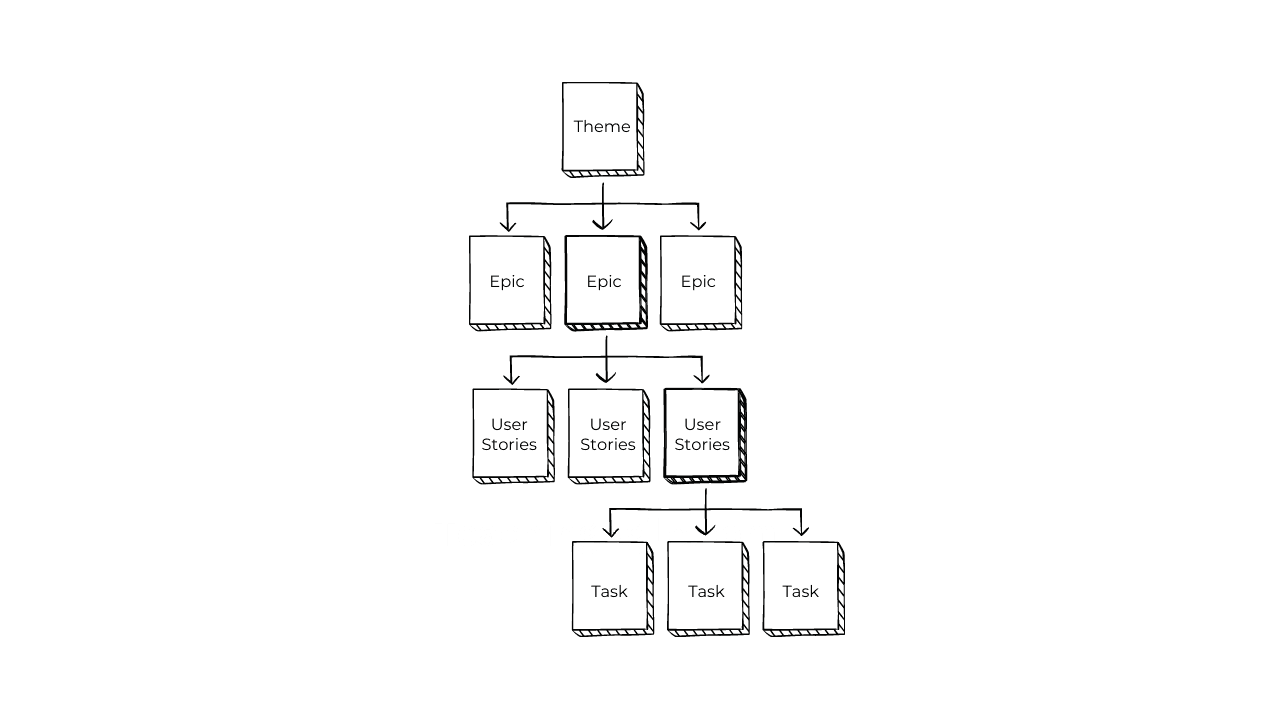
19 Effective Tips for Writing User Stories in Agile Development
 19 Effective Tips for Writing User Stories in Agile Development
19 Effective Tips for Writing User Stories in Agile Development
User stories are the backbone of Agile development, enabling teams to capture user needs and deliver value-driven solutions.
Here is a quick representation of where User Stories fit in the entire landscape of your Agile Development.
 Understanding how Theme, Epics, User Stories and Tasks play a role in Agile Development
Understanding how Theme, Epics, User Stories and Tasks play a role in Agile Development
In this comprehensive guide we will explore 19 tips to help you master the art of writing effective user stories.
Table Of Contents-
- Understand User Needs
- Use the "As a...I want...So that..." Template
- Keep It Simple and Concise
- Define Clear Acceptance Criteria
- Collaborate Across Roles
- Start with Epics
- Prioritize User Value
- Keep Stories Independent
- Use the INVEST Criteria
- Iterate and Improve
- Collaborate with Stakeholders
- Use Concrete Examples
- Avoid Technical Jargon
- Be Open to Feedback
- Include Non-Functional Requirements
- Use Story Mapping
- Focus on User Personas
- Document Assumptions and Constraints
- Keep It Simple
1. Understand User Needs
Before crafting user stories, it's crucial to deeply understand the needs and desires of your target users.
Conduct user research, surveys, and interviews to gain insights into their pain points and goals.
This understanding will help you create user stories that resonate with your audience and provide real value.
Keep in mind that the more you know about your users, the better you can tailor your user stories to address their specific requirements.
User-centricity is the cornerstone of effective user stories. By delving into user needs, you ensure that your stories address actual pain points and deliver meaningful solutions.
2. Use the "As a...I want...So that..." Template
The "As a...I want...So that..." template is a powerful structure that ensures your user stories are concise and focused.
The "As a" section defines the user or role, "I want" outlines their goal or need, and "So that" explains the intended benefit.
This template provides a clear context for the feature or functionality being developed, making it easier for the team to understand the user's perspective and the value being delivered.
The 'As a...I want...So that...' template provides a structured framework that captures the essence of user stories, ensuring clear communication and alignment among team members.
3. Keep It Simple and Concise
Complexity can lead to misunderstandings and confusion.
Craft your user stories using simple language that anyone on the team can comprehend.
Avoid overly technical jargon that might alienate non-technical stakeholders.
Be succinct, focusing on delivering the necessary information without unnecessary embellishments.
This clarity ensures that everyone involved, from developers to testers, has a common understanding of what needs to be achieved.
Simplicity is key when it comes to user stories. Clarity in language eliminates ambiguity and empowers the team to work cohesively towards a shared goal.
4. Define Clear Acceptance Criteria
For effective user stories, define clear and comprehensive acceptance criteria.
These criteria lay out the conditions that must be met for a story to be considered complete.
They provide a shared understanding of the desired outcome and help the development team deliver the expected functionality.
Acceptance criteria act as a bridge between the user story and its implementation, ensuring that the end product aligns with user expectations.
Acceptance criteria act as the litmus test for the successful completion of a user story. They ensure a common understanding of what 'done' looks like and help avoid misunderstandings.
5. Collaborate Across Roles
User story creation should be a collaborative effort involving cross-functional team members such as developers, designers, testers, and product owners.
Collaboration ensures that various perspectives are considered, leading to well-rounded stories that address user needs comprehensively.
Bringing different roles together fosters a shared sense of ownership and encourages discussions that refine user stories.
Cross-functional collaboration enriches user stories with diverse insights, promoting a holistic approach to development and problem-solving.
6. Start with Epics
Begin by capturing high-level user needs in the form of epics.
Epics are larger user stories that encompass broader functionalities or features.
Once epics are established, they can be broken down into smaller, more manageable user stories. This approach allows for a better understanding of the overall project scope and helps prioritize work effectively.
Epics provide a strategic overview of user needs, acting as building blocks for more detailed user stories. Starting with epics aids in creating a clear roadmap for development.
7. Prioritize User Value
When writing user stories, prioritize delivering value to the user.
Focus on features and functionalities that directly contribute to solving user problems or meeting their needs.
This helps ensure that the most important tasks are tackled first, delivering meaningful outcomes in each development cycle.
Prioritizing user value drives development efforts towards creating features that truly matter to users, resulting in a more impactful product.
8. Keep Stories Independent
Ensure that user stories are independent of one another.
Each story should be self-contained and not rely on the completion of other stories to function.
This allows for flexibility in prioritization and prevents bottlenecks that could arise from interdependent stories.
Independent user stories enable parallel development and reduce the risk of project delays due to blocked tasks.
9. Use the INVEST Criteria
Follow the INVEST criteria to evaluate and refine your user stories.
INVEST stands for Independent, Negotiable, Valuable, Estimable, Small, and Testable.
Applying these criteria ensures that your user stories are well-structured, focused, and achievable.
The INVEST criteria act as a checklist to ensure that user stories are of high quality, leading to effective development and delivery.
10. Iterate and Improve
User stories are not set in stone.
As your understanding of user needs evolves and as you receive feedback from stakeholders, be ready to iterate and improve your user stories.
Regularly revisit and refine them to ensure they remain relevant and aligned with the changing project landscape.
Continuous iteration and improvement of user stories reflect the agile mindset, allowing your team to adapt to changing requirements and deliver better results.
11. Collaborate with Stakeholders
Engage stakeholders, including developers, designers, product managers, and users, in the user story creation process.
Collaborative discussions help ensure that everyone has a clear understanding of the user needs, goals, and expectations, leading to more accurate and effective user stories.
Collaboration fosters a shared understanding among team members and stakeholders, leading to user stories that better reflect the true project requirements.
12. Use Concrete Examples
Include concrete examples in your user stories to provide context and clarify expectations.
These examples help the development team understand the user's perspective and enable them to create solutions that align with user needs.
Concrete examples make user stories more tangible, reducing ambiguity and improving the accuracy of development efforts.
13. Avoid Technical Jargon
Write user stories in plain and simple language that is easy for everyone to understand, even non-technical stakeholders.
Avoid using technical jargon that could confuse or alienate team members who are not familiar with the terminology.
Clear and jargon-free language promotes effective communication and ensures that user stories are accessible to all team members.
14. Be Open to Feedback
Encourage open communication and feedback from your team members and stakeholders regarding the quality and effectiveness of your user stories.
Embrace constructive criticism and make adjustments to improve the overall quality of your user stories.
Being open to feedback creates a collaborative environment and helps you produce user stories that better address user needs.
15. Include Non-Functional Requirements
In addition to functional requirements, consider non-functional requirements such as performance, security, and scalability.
These requirements ensure that the software meets quality standards and user expectations beyond just its functionality.
Non-functional requirements contribute to a well-rounded user experience by addressing aspects like performance and security.
16. Use Story Mapping
Story mapping is a visual technique that helps you see the big picture of your product and how individual stories fit into it.
It aids in prioritization and understanding the user journey.
Arrange stories horizontally to represent the user workflow and vertically to show the priority.
Story mapping provides a holistic view of your product and helps you plan and communicate your development efforts effectively.
17. Focus on User Personas
User personas represent different user roles or types.
When writing user stories, refer to specific user personas to ensure that the stories are tailored to their needs.
This approach helps you create a more personalized and relevant product.
Addressing user personas makes your user stories more relatable and targeted.
18. Document Assumptions and Constraints
Document any assumptions or constraints associated with your user stories.
Assumptions are factors that you believe to be true but haven't verified, while constraints are limitations that affect the implementation of a story.
Clear documentation of assumptions and constraints helps manage expectations and potential challenges.
19. Keep It Simple
Lastly, remember the principle of simplicity.
While user stories should capture important details, avoid overcomplicating them with excessive details or unnecessary complexity.
Focus on the essentials to maintain clarity and effectiveness.
Simplicity keeps your user stories concise, easy to understand, and actionable.
Conclusion
Incorporating these 19 tips into your user story writing process can significantly enhance the effectiveness of your Agile development efforts.
Prioritize user needs, collaborate effectively, and continuously refine your user stories for optimal results.